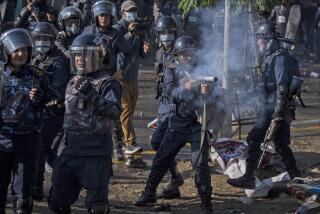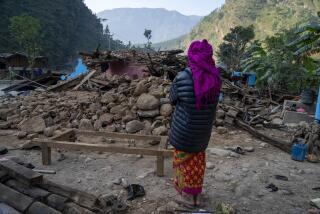Nepal King Yields, OKs Democracy : Asia: Birendra legalizes political parties and sets talks on further reforms. The moves come after eight weeks of protests in the Himalayan kingdom.
- Share via
KATMANDU, Nepal — The monarch who has ruled this Himalayan kingdom with unchecked power for decades yielded Sunday to a popular uprising for democratic reform, legalizing all political parties and paving the way for democracy in Nepal for the first time in 30 years.
King Birendra made his historic announcement after eight weeks of violent confrontations between police and demonstrators that claimed scores of lives and left this capital paralyzed by curfew, unrest and political stalemate.
The king’s decision to permit a multi-party system for only the second time in Nepalese history met the main demand of the leaders of a burgeoning pro-democracy movement. And independent analysts said that it is likely to defuse a political crisis that has shaken the foundation of the nation’s 250-year-old monarchy.
Fireworks, whistles and shouts rose to a spontaneous crescendo from thousands of homes in curfew-bound Katmandu immediately after the king’s 11 p.m. announcement on state-run television.
Before dawn today, the army was withdrawn from the streets of Katmandu, but not before killing one person and injuring more than a half-dozen celebrating the end to the monarchy despite a curfew.
The curfew, however, was lifted during the night, and by mid-morning, crowds of celebrating Nepalese started building throughout the capital--on a day in which the democracy movement’s leaders originally had scheduled protest burnings of the nation’s constitution, which contains the ban on political parties.
The king’s announcement Sunday officially deleted all references to that ban, and he named a panel to meet with opposition leaders and chart Nepal’s course back to democracy. That ended in 1960 when the king’s father staged a palace coup and ousted the only elected government this country has ever had after a 10-year democratic experiment.
The breakthrough in Nepal’s political impasse came after a day of intense negotiations that ended Sunday night, when the king and four of the opposition movement’s leaders met for the first time ever at Birendra’s downtown palace. The palace is just a few hundred yards from the scene of a police crackdown that killed dozens of demonstrators Friday and laid the groundwork for Sunday’s dramatic changes.
Friday’s violence was the culmination of a hard-line government policy in which armed riot police routinely clubbed, arrested and opened fire on thousands of demonstrators throughout the eight-week pro-democracy drive.
The king himself had signaled that he was softening his stance by firing his largely appointed hard-line government Friday morning and freeing hundreds of political prisoners over the weekend.
Even more important, a senior government official confirmed in an interview Sunday evening that the king is now willing to go far beyond his Sunday concessions in future talks.
“The king has no objection to being a European-style monarch,” said the official, who has met routinely with Birendra throughout the crisis. “He is guided by what the Nepalese people want.”
The official’s statement was a strong indication that Birendra, whose family has ruled Nepal through succession for 2 1/2 centuries and now ranks among the world’s oldest monarchies, is prepared to surrender much of his vast power.
The official cautioned that the king, who also remains a strong symbol of Nepalese nationalism despite his waning popularity, will insist on retaining some constitutional authority over his 18 million mainly Hindu subjects, some of whom still believe that he is an incarnation of the god Vishnu.
“In a situation like this one, it is not easy for him to shed all powers,” the official said. “The people have suffered, and the country has suffered when the monarchy was weak. We have to have a monarchy strong enough to prevent (civilian) dictatorships.”
Clearly, the king’s announcement was meant to recast himself as a populist monarch, but most independent analysts agreed that, after Friday’s uprising, he had been left with no choice but to loosen his grip on power and ultimately become a royal figure with little authority.
“This was the king’s last chance,” said one foreign expert who has lived in Nepal for decades. Comparing the situation to Romania, the expert added: “If he hadn’t given in, he would have been in a helicopter doing a Ceausescu within a week. The people’s anger was that deep.”
Government sources acknowledged that Friday’s huge protest by at least 100,000 Nepalese from all walks of life took the palace by surprise and convinced the king that the demand for democratic reform was massive.
In announcing the king’s concessions, state television said that Birendra himself acknowledged the defeat of his hard-line policy, adding that the decision was “based on the international environment and the will of the people.”
After Friday’s violence, which left parts of the capital resembling a war zone, the palace reclaimed control only by calling out the army and imposing a 24-hour curfew, both moves unprecedented in Nepalese history.
The nation’s economy, which is ranked as the world’s third poorest, increasingly was becoming as endangered as the monarchy.
Already, the violence and the curfew have badly hurt Nepal’s tourism industry, which is the country’s second-largest source of revenue after foreign aid. The brutality and suffering damaged the country’s image both as a tourist mecca and an aid recipient.
Thousands of foreign tourists were stranded in hotels that quickly ran short of food in Katmandu, which has become synonymous with trekking holidays in the shadow of Mt. Everest, the world’s highest peak. The government Sunday desperately scrambled to organize half a dozen international flights and ground transportation to the airport after it was closed for nearly 48 hours.
The violence and subsequent crisis also prompted the U.S. Embassy to urge all Americans in Katmandu on Sunday to “seriously consider curtailing their stay.” It also reiterated an earlier State Department advisory that Nepal is too unstable for U.S. citizens to consider as a tourist destination “for the foreseeable future.”
A British tourist was shot to death in Friday’s violence, and two other Europeans were seriously injured.
Meantime, an emergency-room physician at Bir Hospital, which received most of the casualties after police opened fire on Friday’s protest demonstration, said that more than 100 patients with gunshot wounds spent the weekend without enough food and medicine.
The doctor, who said he is a member of the pro-democracy movement and asked not to be named, said that his colleagues were happy to hear the king’s announcement, but he echoed many other Nepalese when he stressed that it will take a long time to heal the nation’s wounds.
“The damage that is done when a person is killed like this,” he said, “cannot be undone in a day.”
BACKGROUND Nepal’s pro-democracy movement launched demonstrations for a multi-party system to replace the monarchy eight weeks ago. The government responded by having riot police shoot, club and arrest protesters. Last Friday, scores were killed and hundreds injured when police opened fire on protesters in the capital, Katmandu. The violence, the worst in the Himalayan kingdom’s recent history, led to talks between King Birendra and the opposition that resulted in Sunday’s announcement of elections and the establishment of a multi-party system.
More to Read
Sign up for Essential California
The most important California stories and recommendations in your inbox every morning.
You may occasionally receive promotional content from the Los Angeles Times.













